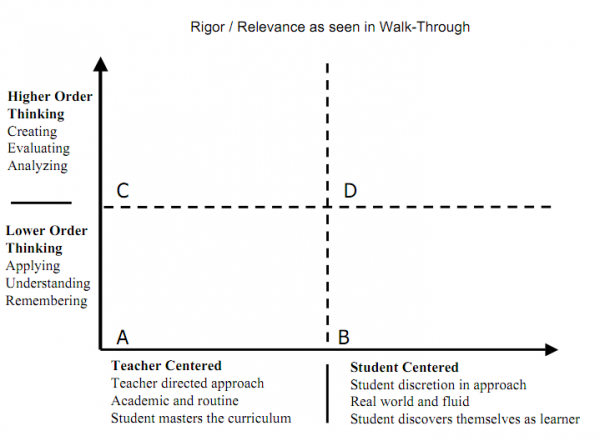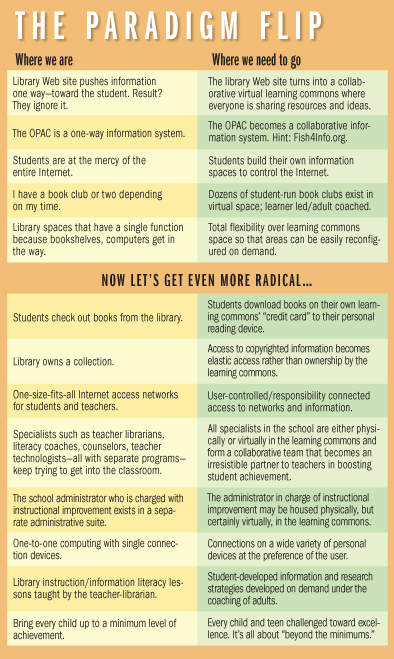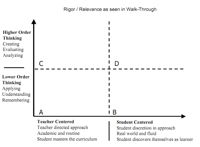We need a reboot. We need a build out. We need a buildup. We need a national makeover. That is why the next few months are among the most important in U.S. history. Because of the financial crisis, Barack Obama has the bipartisan support to spend $1 trillion in stimulus. But we must make certain that every bailout dollar, which we’re borrowing from our kids’ future, is spent wisely.
… It has to go into training teachers, educating scientists and engineers, paying for research and building the most productivity-enhancing infrastructure — without building white elephants…
Transforming Information Flow in School Libraries
"learning commons – both a physical and a virtual space that’s staffed not just by teacher-librarians but also by other school specialists … such as literacy coaches, teacher technologists, teacher-librarians, art teachers, music teachers, and P.E. teachers…"
The main objective of the open commons is to showcase the school’s best teaching and learning practices… a typical classroom assignment and library Web site are examples of one-way communication. Adults tell learners what to do, how to do it, and where to find information. But in the new learning commons, homework assignments and library Web sites offer two-way communication.
… Having done that, note that you have created a revolution in thinking. Directive adults have been transformed into coaches; direct teaching has been transformed into collaborative inquiry.
Principal Academy – Rigor and Relevance Walk-Through Training
The real walkthroughs were beneficial because I was practicing what we discussed in the morning.
This will push me to look for a deeper level of instruction from staff – a deeper level of learning in students.
Just the nudge I needed to "refocus" my professional conversations. I'll be looking at classrooms with a more focused lens.
It makes me want to go back to teaching students – I would be a much better teacher.
21st Century Skills or Adequate Yearly Progress?
The Boston Globe (October 30, 2008) recently reported on efforts to redirect district curriculum to "skills the district has deemed necessary for survival in the 21st century, including critical thinking, invention, problem-solving, and multicultural collaboration."
"Accountability is a good thing. Learning standards are a good thing. But is focusing on one test a fair measure of student success? I think that answer is, 'No,' " said Laura Salomons, a School Committee member since May and a mother of four.
Salomons has submitted a proposal that seeks community support for allowing teachers to avoid tailoring their lessons to the MCAS. Instead, she would like to see teachers directed to instruct students on skills the district has deemed necessary for survival in the 21st century, including critical thinking, invention, problem-solving, and multicultural collaboration.
"I have come to the conclusion that we, as a school district, may be overly consumed with doing well on MCAS," Salomons began in her eight-page proposal. "The focus is a detriment to reaching the school committee and superintendent's goal of 'providing students with . . . learning opportunities that encourage lifelong learning skills and that support a student's artistic, social, emotional and physical development.' " More
I find that I rarely get asked to do staff development to "bring the scores up." Increasingly I'm asked to help teachers create more engaging learning environments for students.
While NCLB began with the admirable goal of narrowing demographic performance gaps and putting an end to sorting kids on the “bell curve,” it may be doing just the opposite. Many of our schools are now compelled to force feed the content required for “adequate progress” as measured by standardized state tests. Does test prep = academic "feed-lot?"
Too little time is left for student-centered, project-based learning that allows students to work at the upper level of Bloom. Innovation requires much trial and error (Bloom’s evaluation). Learning to self-assess your problem solving approach is not a skill fostered in multiple-choice test-prep environment.
NCLB correctly put the focus on student achievement. Our students will need a strong foundation in core concepts. But schools can’t be filled with routine tasks. They need to be fluid environments focused on helping students take responsibility for thinking and problem solving where there sometimes isn’t a right answer.
K-12 Walk Throughs Foster Teacher Reflection

Rigor and Relevance Walkthrough
I recently conducted walk through training (WT) at Hood River County School District in Oregon. I thought the model we used was very effective at engaging teachers and administrators in reflective discussion on instructional practice.
In February, I did half-day presentations on Rigor, Relevance and Literacy to Hood River’s K-5 and 6-12 faculties. In April, I led teams on WTs to give them on opportunity to hone their observational skills. It’s one thing to talk about rigor and relevance in a workshop. It’s another to go into a classroom and try to decide the level of Bloom’s taxonomy being used by the students.
Observers were not in classrooms to evaluate teachers or instructional strategies, but to test their observational skills and have an opportunity to dialogue about their conclusions. We used this simple form to guide our efforts and keep our focus on observation, reflection and discussion. R-R-guide2.pdf 16kb pdf
One day was devoted to K-12 administrative and TOSAs. The next two days were spent with K-12 teacher teams. Each day we began with an orientation session. The team started doing WT’s at an elementary building, then moved to middle and finally, high school. We only visited teachers who had volunteered to host our team. At each building we met periodically to process what we had seen.
The most powerful element of the day, was the K-12 settings of the WTs and the use of K-12 teacher teams. Teachers seldom see other classes in action and it rare that a high school teacher would be given a chance to observe an elementary class or vice versa. All the participants agreed it was a very valuable experience and they came away with greater respect for the contributions being made all each levels of the program. Most importantly, they became more skillful at assessing the rigor and relevance of a variety of instructional strategies. They were then able to apply those perspectives to their own instructional practice. The district intends to support teachers in collegial observation and peer reflection.
For an updated guide for how to conduct classroom walkthoughs see my post: Teacher-Led Professional Development: Eleven Reasons Why You Should be Using Classroom Walk Throughs


